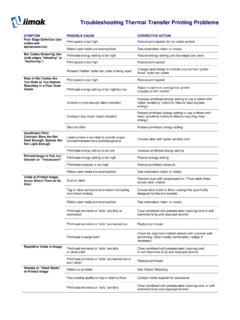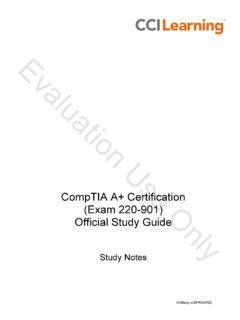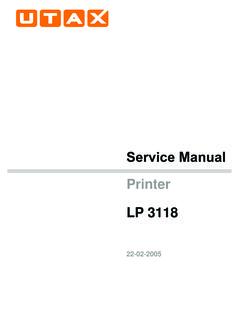Transcription of Power Transformers - Leszek Machalski
1 Marcel Dekker, York BaselTMPowerTransformersPrinciples and ApplicationsJohn J. Winders, Electric UtilitiesAllentown, PennsylvaniaCopyright 2002 by Marcel Dekker, Inc. All Rights 2002 by Marcel Dekker, Inc. All Rights : 0-8247-0766-4 This book is printed on acid-free Dekker, Madison Avenue, New York, NY 10016tel: 212-696-9000; fax: 212-685-4540 Eastern Hemisphere DistributionMarcel Dekker AGHutgasse 4, Postfach 812, CH-4001 Basel, Switzerlandtel: 41-61-261-8482; fax: 41-61-261-8896 World Wide publisher offers discounts on this book when ordered in bulk quantities. For moreinformation, write to Special Sales/Professional Marketing at the headquarters 2002 by Marcel Dekker, Inc. All Rights this book nor any part may be reproduced or transmitted in any form or byany means, electronic or mechanical, including photocopying, microfilming, and re-cording, or by any information storage and retrieval system, without permission inwriting from the printing (last digit):10987654321 PRINTED IN THE UNITED STATES OF AMERICAC opyright 2002 by Marcel Dekker, Inc.
2 All Rights IntroductionPower engineering is the oldest and most traditional of the various areas withinelectrical engineering, yet no other facet of modern technology is currentlyexperiencing a greater transformation or seeing more attention and interestfrom the public and government. But while public concern and political deci-sions about de-regulation and energy trading may reshape the electric utilityindustry s manner of doing business, its future like its past rests on the capabil-ity of its transmission and distribution systems to convey safe, reliable, andeconomical electric Power to homes, businesses, and factories. Nothing ismore essential to this performance than the transformer, which enables modernpower and industrial systems to am particularly delighted to see this latest addition to Marcel Dekker sPower Engineering Transformers : Principles and Applicationsis a comprehensive compendium of theory and practices for electric powertransformers.
3 This book provides a concise but thorough treatment of basictransformer theory, its application to various types of transformer designs andtheir application in utility and industrial Power systems. Its easy to read styleand linear organization make it particularly suitable as a tutorial for those whoneed to learn the material independently, outside of the classroom, or as a textCopyright 2002 by Marcel Dekker, Inc. All Rights formal courses. This book also makes a very good practical reference forutility and industrial Power addition to having concise summaries of all the basics, the text pro-vides an excellent description of the various ancillary equipment and systems,which are often the most difficult to precisely engineer and fit into the Winders has also provided excellent coverage of how to read, interpret,and apply a Power transformer s nameplate data, not always a straightforwardor unambiguous task and one where a surprising number of mistakes are madeby inexperienced engineers.
4 Chapter 8 will be particularly useful to practicingengineers and Power system operators, covering maintenance needs, testingoptions, and troubleshooting techniques and their use, and discussing reliabil-ity of the editor of the Power Engineering series, I am proud to includePower Transformers : Principles and Applicationsamong this important groupof books. Like all the books in Marcel Dekker s Power Engineering series,this book provides modern Power technology in a context of proven, practicalapplication, useful as a reference book as well as for self-study and advancedclassroom use. Marcel Dekker s Power Engineering series includes books cov-ering the entire field of Power engineering, in all of its specialties and sub-genres, each aimed at providing practicing Power engineers with the knowl-edge and techniques they need to meet the electric industry s challenges inthe 21st Lee WillisCopyright 2002 by Marcel Dekker, Inc.
5 All Rights book is based on notes for the Transformer Applications Course offeredby the Center for Power System Study at Lehigh University. The key wordin both the title of that course and the title of this book isapplications. Thematerial presented in the following chapters was obtained from varioussources: textbooks, industry standards, and established utility practices andprocedures. Much of this material also comes from my personal files relatingto actual events and case studies that were observed during my career in theutility industry spanning 30 are many kinds of Transformers , and all share the same set offundamental operating principles. Since this book focuses onpowertransform-ers, it is fair to ask, What exactlyisa Power transformer? By definition,a Power transformer is a transformer which transfers electric energy in anypart of the circuit between the generator and the distribution primary circuits.
6 *This definition of Power transformer in the IEEE standard appears under the* IEEE Std. IEEE Standard Terminology for Power and Distribution Transform-ers. Institute of Electrical and Electronics Engineers, Inc., 1978, New York, p. 2002 by Marcel Dekker, Inc. All Rights of Size and does not indicate how the transformer is used in thepower system. Thus, this book uses this definition in the broadest sense toinclude discussions of specialty applications such as step voltage regulators,phase shifters, and grounding Transformers , as well as the usual step-up andstep-down applications. Since the line between Power Transformers and distri-bution Transformers is somewhat blurry, many of the basic principles presentedcan be applied to distribution Transformers as first several chapters build a solid theoretical foundation by describ-ing the underlying physics behind transformer operation.
7 A theoretical founda-tion is absolutely necessary in order to understand what is going on inside atransformer and why. The magnetic properties of materials, a review of mag-netic units, and analysis of magnetic circuits are discussed with enough mathe-matical rigor for the interested reader to gain full comprehension of the physicsinvolved. Whenever a detailed mathematical treatment is presented, it is al-ways done with a practical objective in mind. Each chapter includes a numberof practice problems to clearly illustrate how the theory is applied in everydaysituations. Many of these practice problems are based on actual things set this book apart from other transformer referencebooks. First, this book emphasizes the importance of magnetic properties andhow the choice of a core design can affect the transformer s electrical proper-ties, especially during faults and unbalanced operations.
8 Many reference booksoverlook this critical aspect of transformer , this book discusses special types of transformer connections, suchas the zigzag, Scott, and tee connections, as well as the more common wyeand delta types. The Scott and tee connections, which transform three-phasevoltages into two-phase voltages, are seldom covered in modern transformerreference books even though two-phase systems still exist today. Tap changingunder load and variable phase shifting Transformers are covered. Differenttypes of transformer coil and coil construction are compared, with discussionof the particular advantages and disadvantages of each with respect to thevarious transformer connections. The reader will also gain insight into someof the economic trade-offs of different transformer design brief tutorial on symmetrical components is also included. The topicis covered in other reference books but seldom in such a compact and straight-forward way, enabling the reader to immediately apply the technique in practi-cal section of the book defines a transformer s nameplate rating versusits thermal capability and describes how to calculate a transformer s rate ofloss of life.
9 An entire chapter is devoted to describing abnormal operatingconditions that can damage Power Transformers , including overloads, shortCopyright 2002 by Marcel Dekker, Inc. All Rights , single phasing from primary fuse operations, ferroresonance, andvoltage surges. The chapter describes ways to avoid these conditions, or atleast ways to mitigate them through proper system design and selection ofappropriate transformer reader will learn how to interpret and use a transformer test reportas well as the information on the transformer nameplate. The book concludeswith a comprehensive discussion of preventive and predictive maintenance,good utility practices, factory and field testing, and failure rate book is intended primarily for readers having an electrical engi-neering background although training as an electrical engineer is not neces-sary, and others will also benefit from the conclusions that can be drawn fromthe practical examples.
10 Mastery of the principles presented in this book willprovide a sound working knowledge of how to specify, operate, and maintainpower Transformers in a utility or plant wish to thank Anthony F. Sleva for his thorough review of the manu-script and his many helpful suggestions for improving it, and for making itpossible to publish this book. I am indebted to the late Charles H. Morrison,who patiently shared with me so much of his extensive theoretical and practi-cal knowledge about Power J. Winders, 2002 by Marcel Dekker, Inc. All Rights Completing the Transformer by Adding a SecondWindingCopyright 2002 by Marcel Dekker, Inc. All Rights Connectionandthe Comparisons of Economy of the Different Trade-Off Between Steel and Copper in the Design of Connecting Three-Phase Banks Using Transforming Three-Phase Voltages into Transformer Equivalent Circuits Modeled in Zero Matching Transformers for Parallel and BankOperationsCopyright 2002 by Marcel Dekker, Inc.


